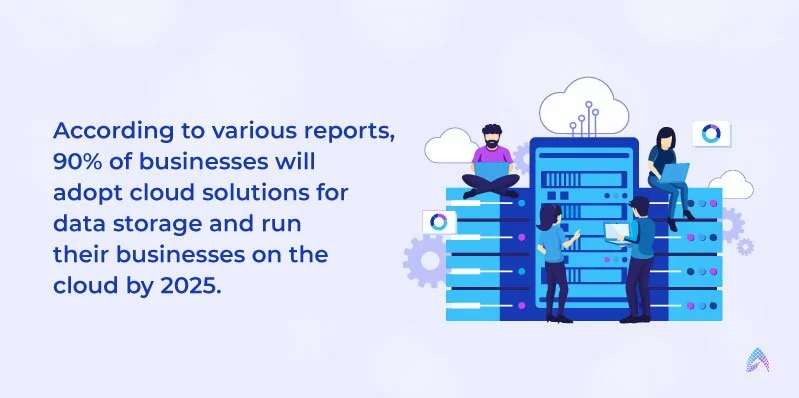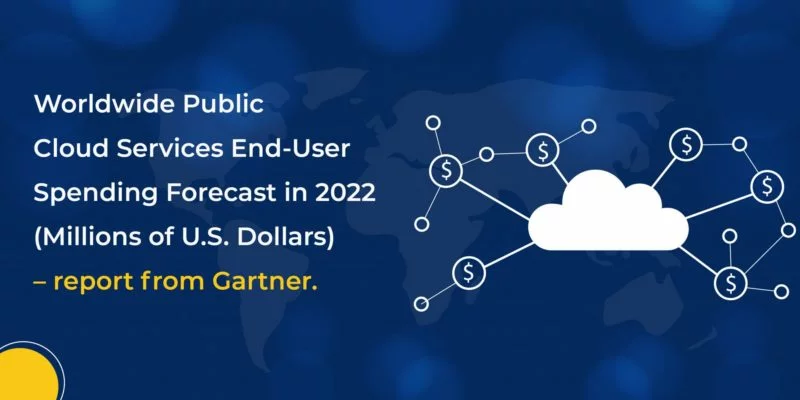7 Steps For a Successful Enterprise Cloud Migration Strategy

A cloud migration strategy will help you simplify business operations, freeing up your time to focus on strategic planning instead of mundane tasks. As discussed in our previous blogs, cloud migration solutions can both significantly reduce infrastructure maintenance costs and the time it takes to develop and deploy applications.
Check out the top benefits of embracing cloud migration solutions for your business.
Cloud migration is a key part of the future for any businesses looking to improve productivity and ROI while reducing their carbon footprints. While choosing these benefits is an easy decision, the act of migrating a business to the cloud is not as simple. In order to eliminate downtimes and process disruptions while migrating data and infrastructure to the cloud, it’s important for your organization to have a cloud migration strategy.
Before we dive into that, let us recall a famous quote about reaching our destination.

Do you have any plans to migrate your business to the cloud in 2022? If so, keep the above quote as a reminder that a cloud migration process without a strategy doesn’t guarantee any results.
What happens if you don’t run your business on the cloud?
Well, let us give you a simple example. Imagine that you recently developed and launched a real estate app. You decided to host the app’s infrastructure on a local server because you did not expect a lot of immediate users.
But then your app goes viral due to its ubiquitous features and location-specific services. You get 100,000 mobile app downloads in the first month, and user queries are flooding your inbox. What is otherwise a great start for your business is being limited by unpreparedness, specifically the infrastructure you chose to help with the app’s launch is instead a major roadblocks to scalability.
Do you know what will happen next? Since you are not yet ready to handle such huge loads, your app will not work correctly and display an error page instead of the app home page.
This is always a frustrating experience for your customer and can make them both lose trust in your business and hesitate to refer it to others.
On the other hand, cloud solutions can help you host a database and use infrastructure for seamless business operations and scalability. Major companies like Facebook, Netflix, and Amazon run on cloud solutions that ensure their businesses are always up and running and have uncompromised scalability.

Amzur’s case study:
Would you be interested to know how one of our clients from the real estate industry overcame the challenges associated with traditional lead management and scalability with AWS cloud solutions?
MAPS Technologies Case Study
Get free access to our MAPS Technologies case study to know how Amzur helped them master the lead nurturing process and propel their business growth.
How to build an on-premises to cloud migration strategy in 7 steps
To be successful with cloud migration, it is imperative to have a tailored cloud migration strategy that evaluates existing resources and workloads and understands what they need in the future.
Here, we’ll discuss the top 7 steps to building a successful strategy for on-premise to cloud application migration.
Cloud migration process step 1: Build a cloud migration team
Whether you’re working on small application development or an enterprise-level shift, your internal team’s capabilities are crucial to making the project successful. That’s why it’s important to check the technical expertise and readiness of your internal team before implementing cloud migration. If you learn about any skills gap, then you can hire the appropriate resources or collaborate with the right external cloud services provider.
Let’s look at the top 6 roles required for a cloud migration project team:
- Executive sponsor: The person in charge of creating or approving a cloud data migration strategy.
- Field general: Handles project management and cloud migration process execution.
- Solution architect: A cloud solutions developer, preferably an experienced one who has completed several cloud migration projects.
- Cloud administrator: A person who is an expert in virtual machines, cloud networking, development, and deployment on IaaS and PaaS.
- Cloud security manager: Handles all operations associated with the organization’s strategy.
- Compliance specialist: Ensures your organization meets all security protocols and complies with modern standards.
If you have limited time and budget, you can’t afford to rely on traditional hiring practices to yield good results. Instead, collaborate with a third-party cloud services provider in the USA such as Amzur Technologies to make it happen without worrying about skills and hiring hiccups.
Check out our blog to learn more about the impact of delayed hiring on overall productivity.
Cloud migration process step 2: Choose cloud service model
This is one of the crucial steps in executing your cloud migration strategy. Since there are many different cloud service models available on the market, you must learn which to choose to meet your evolving business needs. These are the top 3 cloud service models you should look for:
1. SaaS: Software as a service cloud model
As an organization, you likely need a few software applications for short-term purposes and others for the long term. But, what if you lack the adequate budget, time, and technical skills? Well, you reach out to an experienced app development company to meet your needs.
The SaaS cloud service model eliminates all the clutters of application development. Instead, you can choose an application on a subscription basis and pay for what you’ve used, saving time and budget.
2. IaaS: Infrastructure as a service cloud model
Setting up a business model can be expensive in terms of purchasing, deploying, and maintaining infrastructure. It requires extensive technical supervision and continuous power supply to ensure business continuity and a seamless customer experience.
IaaS is a consumption-based model where you pay on the go only for the resources you have used. With this model, you can seamlessly scale up or down the services associated with servers, networking, and storage as needed.
3. PaaS: Platform as a service cloud model
Every organization needs different applications that were built on various platforms. As your business grows, finding the perfect collaboration between all the applications and platforms will help you deliver on your goals. On the other hand, compatibility issues can lead to process disruptions and downtimes.
PaaS cloud models ensure your applications are platform-independent and run seamlessly on any platform. Another benefit with PaaS is the cloud service provider will resolve and issue updates and fixes.
Cloud migration strategy step 3: Decide the level of cloud integration
While migrating to the cloud, not every application needs a full-blown cloud migration strategy. Some applications need complete migration, while others need partial migration. Therefore, you must build cloud migration strategies that meet your evolving and specific needs.
1. Lift and shift:
Lift and shift is the easiest way of doing cloud migration. In this process, the cloud services provider will implement the “Rehosting” procedure, where the existing applications will be deployed either on a single or multi-cloud environment with minimal changes.
2. Extend to the cloud:
For mission-critical applications, extending to the cloud is the best cloud migration strategy to shift the underlying infrastructure of existing applications. Here you can adopt cloud IaaS to scale up and down as per the ongoing needs. This saves time and costs.
3. Cloud optimized:
As opposed to the existing cloud method, a cloud-optimized migration strategy is a process of keeping a few applications on-premises and migrating others to the cloud by rewriting their codes. This process enables a hybrid deployment model and takes advantage of modern technologies like AI, ML, and analytics.
4. Cloud-native:
In this cloud migration scenario, organizations build applications from scratch and redeploy them in the cloud environment. As the name suggests, this cloud-native scenario leverages the benefits of PaaS and serverless architecture to make applications scalable and robust. Comparatively, it takes more time and resources to develop cloud-native applications for seamless business growth.
5. Replace with SaaS:
With the advent of modern technologies, legacy applications have become transient. However, continuous development, launching, and maintenance of apps are crucial and resource-intensive. In this scenario, cloud SaaS applications have become prominent in managing a few internal applications like HR, sales management, and internal communication.
Ex: The Zoom, Slack, Keka, and Teamwork applications are good examples of SaaS solutions.
Cloud migration process step 4: Define a cloud solution type
Choosing which type of cloud is one of the influencing factors of the cloud application migration process success. That’s why you should choose among public, private, hybrid environments before migrating.
1. Public cloud solutions:
The public cloud is the best option when you need a development and testing environment for your applications. Here, you collaborate with an experienced cloud services provider to host your applications or simply access their services. However, note that the public cloud migration strategy is not a viable option for mission-critical applications that deal with sensitive data. In other words, that’s because as the saying goes, “Don’t put all your eggs in one basket.”
2. Private cloud solutions:
Instead of hosting applications on the public cloud where you have little control over data and ownership, you can build a private cloud to run your applications and the entire infrastructure. If you have an adept team of cloud experts, the development of private cloud solutions is recommended.
3. Hybrid cloud solutions:
Here you reap the benefits of both public and private cloud solutions. Public cloud solutions are used to host applications that need frequent upgrades and access by users. Meanwhile, mission-critical and data-sensitive applications will be hosted on the private cloud to improve security and scalability.
Above all, we would like to give a few strong reasons to adopt cloud migration technologies and cloud-native apps in 2022. Here is a recent report from Gartner about cloud adoption growth.

| 2020 | 2021 | 2022 | |
|---|---|---|---|
| Cloud Business Process Services (BPaaS) | 46,131 | 50,165 | 53,121 |
| Cloud Application Infrastructure Services (PaaS) | 46,335 | 59,451 | 71,525 |
| Cloud Application Services (SaaS) | 102,798 | 122,633 | 145,377 |
| Cloud Management and Security Services | 14,323 | 16,029 | 18,006 |
| Cloud System Infrastructure Services (IaaS | 59,225 | 82,023 | 106,800 |
| Desktop as a Service (DaaS) | 1,220 | 2,046 | 2,667 |
| Total Market | 270,033 | 332,349 | 397,496 |
Cloud migration process step 5: Create a cloud migration project plan
By step 5, you’ve come a long way in choosing your cloud partner and deployment models. In this phase, you start migrating applications, data, and infrastructure to the cloud while keeping your business operations up and running to avoid downtimes and process disruptions.
By 2024, Gartner predicts that 45% of IT spending within organizations will shift from traditional solutions to the cloud.
Cloud migration step 6: Set KPIs, or key performance indicators, that are trackable and measurable.
Migrating to the cloud with vanity metrics is of no use. You must have a predefined set of KPIs to ensure the success of your cloud migration process. Identifying and tracking these KPIs will help you refine strategies in a timely manner and make the process error-free.
Here are a few KPIs that you should define before the migration process:
- User experience indicators such as lag or response time
- Application performance indicators, including error rates and availability
- Infrastructure KPIs such as memory usage, CPU usage, and network throughput
- Rollout time for new features
Cloud migration procedure step 7: Test, review, and make necessary adjustments
No project will be a successful rollout with no hiccups. They have to go through a lot of validation checks and review phases to eliminate errors and make the cloud migration project successful. Then after migration, check what’s working and what isn’t, and make necessary changes.
Amzur’s cloud consulting and migration services:
A successful cloud migration strategy should maximize your business value while minimizing migration time, effort, cost, and risk. Collaborating with an experienced cloud migration services provider like Amzur allows you to seamlessly migrate your business infrastructure to the cloud while minimizing the risks of security and downtimes.
Want to make your business scalable and improve the humanized approach to achieve better revenue growth? Get in touch with our cloud experts today. We are a leading cloud services provider in Tampa, Florida, USA, with 15 years of rich experience in supporting startups and SMEs through their digital transformation journey.
Let us understand your business challenges.

Director – Global Delivery




